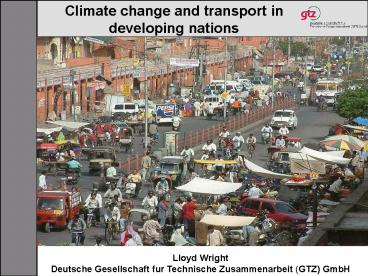Lloyd Wright - PowerPoint PPT Presentation
1 / 15
Title:
Lloyd Wright
Description:
Ciclov a Sunday (120 km of car-free roadways) 250 km of high-quality cycleways ... Restraints on car use. Bogot 's global impact. Cities with BRT projects in ... – PowerPoint PPT presentation
Number of Views:93
Avg rating:3.0/5.0
Title: Lloyd Wright
1
Climate change and transport in developing nations
Lloyd Wright Deutsche Gesellschaft fur Technische
Zusammenarbeit (GTZ) GmbH
2
The transport sector and greenhouse gas emissions
3
Transport and the UNFCCC mechanisms
4
Framework for transport emissions
Land-use (urban form)
Fuel efficiency (technology)
- Land-use
- Zoning
- Route structure
- Vehicle mgmt.
- Affordability
- Comfort
- Convenience
- Load factor
- Safety
- Security
- Travel time
- Fuel type
- Propulsion system
- Maintenance
- Driver behaviour
- Dedicated lanes
- Dwell times
5
Mode share versus technology
The impact of gaining one more bus load of
passengers
Bus equivalents
Assumptions 120 passenger bus at 50
occupancy 5 people switching from autos, 35
switching from other motorised vehicles, and 15
switching from non-motorised transport Source
International Energy Agency, 2002
6
Conclusions of mode share vs. technology
Regardless of whether a bus is clean or
dirty, if it is reasonably full it can displace
anywhere from 5 to 50 other motorised
vehicles... Certainly, a cleaner bus will
yield lower emissions, but in this scenario the
emission reductions from technology choice are
overshadowed by reductions from mode switching
(and the resulting subtraction of other
vehicles)...Dramatic reductions in road space,
fuel use, and most emissions can be achieved
through displacing other vehicles with any bus,
even the Euro 0 buses typically sold in the
developing world. Source IEA, 2002
7
Bus rapid transit (BRT)
Bus Rapid Transit is a mass transit system that
mimics the rapidity and performance of metros
but utilises buses rather than rail vehicles.
Bus Rapid Transit 0.3 - 10 million / km
Bogotás TransMilenio BRT system By 2015,
TransMilenio will serve 5 million passengers per
day over 388 kilometers of busways.
8
What do customers want?
Aesthetically-pleasing environment
Lighting and security
Rapid boarding
Courteous drivers
Easy to understand maps
9
TransMilenio greenhouse gas reductions
Avoiding the leakage of older vehicles by
scrapping 7.0 to 8.9 older buses for every new
articulated bus introduced
- 20 of TransMilenio users formerly drove private
vehicles - Estimated greenhouse reductions for first 30
years of operation 15 - 25 million metric tons
of CO2-equivalents
10
Complementary measures in Bogotá
- Ciclovía Sunday (120 km of car-free roadways)
- 250 km of high-quality cycleways
- Worlds largest car-free weekday
- Worlds longest pedestrian corridor
- Major effort to recuperate public space
- Restraints on car use
11
Bogotás global impact
Cities with BRT projects in development
Accra, Ghana Cape Town, South Africa Dakar,
Senegal Dar es Salaam, Tanzania
Beijing, China Delhi, India Hanoi,
Vietnam Jakarta, Indonesia
Guatemala City, Guatemala Lima, Peru Mexico City,
Mexico Santiago, Chile
12
Replication
Curitiba, Brazil
Quito, Ecuador
Taipei, Taiwan
Rouen, France
Nagoya, Japan
Brisbane, Australia
13
City transformations
Seoul, South Korea
14
GTZ Sourcebook
Sustainable Transport A Sourcebook for
Policy-Makers in Developing Cities
www.sutp.org
- Sample modules
- Bus rapid transit
- Non-motorised transport
- Mass transit options
- Bus sector reform
- Mobility management
- Inspection and maintenance
- Air quality management
15
The path to sustainable transport
1. To date, the transport sector has played a
surprisingly small role in mitigation efforts
under the UNFCCC mechanisms.2. The current
focus on fuel switching has meant that transport
measures are generally not cost competitive or
realizable in the short term (e.g., fuel
cells).3. However, shifting mode share from
private motorised vehicles to public transport
and non-motorised transport can enable the
transport sector to compete in mitigation efforts.































